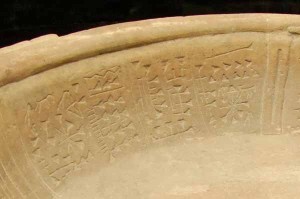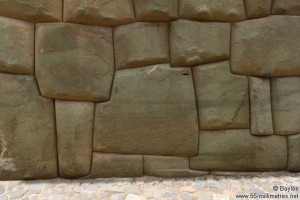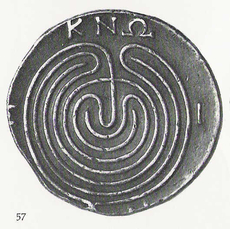April Holloway
Fuente Magna Bowl
 The Fuente Magna Bowl is a remarkable artefact sometimes called ‘the Rosetta Stone of the Americas.’ It was discovered accidentally near Lake Titicaca in Bolivia. The bowl’s claim to fame is that it has been inscribed with cuneiform writing, similar to Sumerian.
The Fuente Magna Bowl is a remarkable artefact sometimes called ‘the Rosetta Stone of the Americas.’ It was discovered accidentally near Lake Titicaca in Bolivia. The bowl’s claim to fame is that it has been inscribed with cuneiform writing, similar to Sumerian.
It is claimed that thermoluminescence dating has shown the object to be quite ancient and not a forgery. The same site(a) quotes at length a translation of the text by Clyde Winters, but a German website(b) denounces his translation as nonsense, although it accepts that the Bowl as genuine. Another site(c) offers a selection of detailed images of the Bowl.
Carl Feagans’ website(f) is equally critical of Winters’ ‘translation’ and raises a number of questions regarding the authenticity of the artefact.
April Holloway offered an overview of the controversy relating to the Fuente Magna Bowl on the Ancient Origins website, concluding quite reasonably, that further objective linguistic research could bring the debate to a conclusion(g).
Jim Allen and his supporters have sought to link the Bowl with the theory of Atlantis in the Andes(d).
The bad archaeology website has a reasonably balanced article(e) on the bowl which should be read.
>Michel Leygues has published(h) his study of the Fuente Magna Bowl in which he endeavours to demonstrate the relationship between Sumerian, Akkadian, Aymara and Quechua. Unfortunately, so far it is only available in French.<
(a) https://web.archive.org/web/20110727221012/http://www.world-mysteries.com/sar_8.htm
(c) See: https://web.archive.org/web/20160613101558/https://www.faculty.ucr.edu/~legneref/biados/fuentmag.htm
(e) https://badarchaeology.wordpress.com/tag/fuente-magna-bowl/
(f) https://ahotcupofjoe.net/2017/11/fuente-magna-bowl-not-cuneiform-not-sumerian/
Labyrinth *
Labyrinths, are one of the many mysteries of the ancient world, with the earliest examples apparently dating back around 4,000 years(t). In Egypt, around 1800 BC Pharaoh Amenemhet III was responsible for building what is reputed to have been the largest labyrinth at Hawara containing three thousand rooms according to Herodotus, who visited it in the 5th century BC. Herodotus’ description inspired Athanasius Kircher to draw a plan of the underground complex(u).
The Labyrinth along with the double-headed axe, the labyris, are usually associated with Minoan culture. However, the labyrinth is an ancient symbol found around the world in locations such as Italy(s), India(g), Egypt(h), England(q), Finland(r)and even in the New World as Evan Hadingham has shown an example [1309.261] at Pacatnamú in Peru. In Scandinavia, they are known as Troy Towns – Trojeborgar. Sweden has the greatest number with 200(e).
The largest example in Sweden was discovered at the Mesolithic site on Blå Jungfrun Island(j).
Tracy Boyd, in a lengthy paper(m) about Chartres Cathedral, mentions in footnote 27 that “Many of the labyrinths originally installed in cathedrals in France were later destroyed by the Church itself”!
Eberhard Zangger claimed that “most labyrinths are found around the Mediterranean” and “that at the end of the Bronze Age, the labyrinth was a recognised pattern around the eastern Mediterranean.” [484.136] He proceeds to link the labyrinth with Troy, which, in an earlier book [483] he had identified as Atlantis.
India’s second-largest example, measuring 56 feet by 56 feet, was partly uncovered in Gedimedu near Pollachi(i) in 2015. It is estimated to be 2,000 years old and has a design similar to those found on clay tablets found at Pylos, Greece, from 1200 BC.
Labyrinths were also incorporated into very many churches and cathedrals throughout Europe. Lucile Taylor Hansen gives some examples of mazes in the United States[572.276].
It has been suggested by a number of writers that the labyrinth had some connection with Atlantis(a)(b). Such suggestions are interesting but highly speculative. Lewis Spence does so in The History of Atlantis. J. D. Brady touches on this in his book, Atlantis[0738] where he announced that Atlantean gold treasure was to be found within a labyrinth on the Greek island of Lemnos.
What I find interesting is that so many widespread examples of the labyrinth retain the irregular elements of the symbol even when depicted in a rectangular rather than a rounded style. An extensive website covering all aspects of labyrinths and mazes is worth a visit(c). There is also The Labyrinth Society(f) to further whet your appetite.
In 2014 an article(o) by April Holloway described a collection of labyrinths that I consider the most mysterious of all. They are situated on Russia’s Solovetsky Islands (or Solovki), which “are an archipelago located in the Onega Bay of the White Sea, Russia. It is here where there can be found thirty-five Neolithic labyrinths, known as ‘vavilons’ (‘Babylons’) in the local dialect, which date back to around 3,000 BC. The most remarkable are the stone labyrinths of Bolshoi Zayatsky Island, a group of fourteen labyrinths in a 0.4km 2 area.” The Atlas Obscura website offers a number of images(p).
In 2017, an extensive article by John Reppion offers further information on the history and geographical spread of labyrinths(k). Similarly, Gary Vey offers an article with additional information and more images(l).
Some researchers have attempted to link the outline of the labyrinth with the concentric design of the harbour of Plato’s capital city. The harbour was described as a series of perfectly concentric circular features ‘as if created on a lathe’ (Critias 113d), whereas the labyrinth is more spiral with a slightly offset entrance. My conclusion regarding the labyrinth is; fascinating– yes, Atlantis – probably not.
The persistent use of this ancient symbol was highlighted by an aerial image, sent to me by Hank Harrison, of a Catholic school in California.
(a) MMM Group Home Page (archive.org)
(b) www.duepassinelmistero.com/Il%20mito%20di%20Atlantide.htm
(c) Labyrinthos Homepage (archive.org)
(e) https://www.mymaze.de/trojaburg_en.htm
(f) The Labyrinth Society: The Labyrinth Society: Sacred Geometry and Labyrinths (archive.org) *
(h) https://www.ancient-origins.net/ancient-places-africa/lost-labyrinth-ancient-egypt-part-1-002033
(k) https://dailygrail.com/Guest-Articles/2017/7/The-Labyrinths-Troy
(l) Labyrinth: walk on the wild side / Viewzone
(m) our lady of chartres (archive.org)
(o) https://www.ancient-origins.net/ancient-places-asia/ancient-stone-labyrinths-bolshoi-zayatsky-001573
(p) https://www.atlasobscura.com/places/bolshoi-zayatsky-island
(q) https://andrewgough.co.uk/articles_land/
(r) Labyrinths and Ritual in Scandinavia | BLADE HONER (wordpress.com)
Crespi Collection
The Crespi Collection is a remarkable assortment of many thousands of artefacts gathered together by the late Father Carlos  Crespi Croci (1891-1982), an Italian Salesian monk who did missionary work among the natives of Cuenca, Ecuador. The collection of objects includes gold, silver and a variety of alloys together with ceramics and tablets with unusual writing. The local Indians who allegedly found them in subterranean caves brought these goods to him. There is no doubt that Fr. Crespi knew that some of the artefacts offered to him were modern, made by locals who were able to get a little bit of charitable assistance while preserving their dignity. Father Crespi never properly catalogued them and over time a number of items were apparently stolen. At present some of these artefacts are stored in the church of Maria Auxiliadora in Cuenca. The caves referred to were apparently located by the late Juan Moricz in 1965. Erich von Däniken wrote about the caves and Moricz in one of his fantasy books, Gold of the Gods.
Crespi Croci (1891-1982), an Italian Salesian monk who did missionary work among the natives of Cuenca, Ecuador. The collection of objects includes gold, silver and a variety of alloys together with ceramics and tablets with unusual writing. The local Indians who allegedly found them in subterranean caves brought these goods to him. There is no doubt that Fr. Crespi knew that some of the artefacts offered to him were modern, made by locals who were able to get a little bit of charitable assistance while preserving their dignity. Father Crespi never properly catalogued them and over time a number of items were apparently stolen. At present some of these artefacts are stored in the church of Maria Auxiliadora in Cuenca. The caves referred to were apparently located by the late Juan Moricz in 1965. Erich von Däniken wrote about the caves and Moricz in one of his fantasy books, Gold of the Gods.
Further details about Fr. Crespi and his collection can be read in a paper by Marina Ivanova(g).
A somewhat eccentric website(a) from Stanley Hall expands on the story but without any real supportive proof. Among the collection is what appears to be a parapegma or calendar of a type developed in Greece in the 5th century BC.
Many wild claims have been made about this strange assortment, including a link with Atlantis. Richard Wingate devoted a large section of his book, The Lost Outpost of Atlantis,[059] to the Crespi Collection.
It was over twenty years later that Wingate again wrote at length about Crespi in his 2011 book, Atlantis in the Amazon[771]. He describes how Crespi had much of his collection taken from him and recounts his last meeting with Fr. Crespi shortly afterward, leading me to wonder why it took nearly thirty years to record this story.
Nevertheless, a 2015 blog from Jason Colavito(b) offers evidence that the objects in question were fakes and that the elderly Father Crespi was unable to distinguish between tin and silver or brass and gold. He also recounts how Erich von Däniken exploited Crespi’s ‘collection’ and fraudulently claimed to have visited the caves mentioned by Juan Moricz in Gold of the Gods[272].
In 2016, April Holloway on the Ancient Origins website(c) offers further evidence that most of the objects purporting to be of trans-oceanic origin or influence are fakes. However, while I fully accept that most of the objects are fakes, there are a few that are more difficult to explain.
One of these(d) is so remarkably like Roman parapegmata, that I find it difficult to casually dismiss it! Parapegmata are a type of calendar originally developed in Greece during the 5th century BC(i). A full dissertation on the subject>was published by Daryn Lehoux with the first chapter available online(h) as well as a Bryn Mawr review(j). <
In a follow-up to Holloway’s article, Ancient Origins co-founder, Dr Ioannis Syrigos, decided to investigate further the matter of gold artefacts missing from the collection shown to Holloway. He reports that he was met with obfuscation and threats(e).
>Vladimir Pakhomov also commented on the parapegma of Fr. Crespi and concluded, rather hastily in my opinion, that people “in ancient Rome, Greece, Egypt and South America all were using the same calendar – parapegma.”<
Commenting on Syrigos’ report, Jason Colavito has suggested that the missing gold pieces were a consequence of corruption or greed rather than conspiracy(f).
(a) See: https://web.archive.org/web/20060221130241/https://www.goldlibrary.com/index.htm
(b) https://www.jasoncolavito.com/blog/father-crespi-and-the-toilet-tank-float-of-the-gods
(d) https://dominorus.majestic64.com/parapegma.html (link broken)
(g) https://ancients-bg.com/the-collection-of-mysterious-artifacts-of-padre-crespi/
(h) 0521851815 crop.pdf (cambridge.org) *
(k) South American Calendar Parapegma (archive.org) *
Cuzco
Cuzco is a provincial capital of modern Peru, which in the 11th century was the capital of the Inca Empire. One remarkable sight in the city is the 12-angle stone in the wall on Hatun Rumiyoc Street, which has now been outdone by a 13-angle stone, recently identified, which is built into an irrigation system at the Inkawasi archaeological site, located in Huancavelica region’s Huaytará district(c). The astonishing mortarless Inca masonry in the town has to be seen to be believed.
A few years ago Davide Andrea published his theory on how the Incas fitted those multi-angled stones(d). April Holloway has touched on the suggestion that the Incas or their predecessors had discovered how to soften stone(g). An extensive four-part article elsewhere(h) focuses on the Sri Lankan site of Sigiriya. where what appears to be numerous examples of softened stone can be seen. However, the author concluded that what was on display were features that had been cast in situ and that the same method had been employed when building the pyramids and creating the huge monoliths of Baalbek! It is worth noting that Andrea concluded that “we’re still unsure of how the Incas fit the stones so perfectly”.
The city of Cuzco contained The Corichancha, (Place of Gold), which the Incas dedicated to Viracocha and which astounded the Conquistadors in the 1530s when confronted with its opulence(b). It was  covered inside and out with over 700 sheets of gold and silver. The nearby Garden of the Sun contained golden animals, birds and plants. Pipes, aqueducts and basins were also made of gold. The complex was fed by natural hot and cold springs. Apart from all this ostentatious wealth, some writers have drawn further parallels between Plato’s Atlantis, Homer’s Phaeacia and the Cuzco of the Incas. Although nobody, so far, has suggested that Cuzco had been the location of Atlantis it has been mooted that it may have been constructed as a reminder of the glory of a previous homeland. Donnelly considered Peru to be an Atlantean colony. Local people are clearly not unaware of the suggestion that Cuzco has been associated with Plato’s lost city and so you will find the Atlantis Hotel within a few blocks of the main square.
covered inside and out with over 700 sheets of gold and silver. The nearby Garden of the Sun contained golden animals, birds and plants. Pipes, aqueducts and basins were also made of gold. The complex was fed by natural hot and cold springs. Apart from all this ostentatious wealth, some writers have drawn further parallels between Plato’s Atlantis, Homer’s Phaeacia and the Cuzco of the Incas. Although nobody, so far, has suggested that Cuzco had been the location of Atlantis it has been mooted that it may have been constructed as a reminder of the glory of a previous homeland. Donnelly considered Peru to be an Atlantean colony. Local people are clearly not unaware of the suggestion that Cuzco has been associated with Plato’s lost city and so you will find the Atlantis Hotel within a few blocks of the main square.
>Just 2 km north of Cuzco’s main square lies the remarkable fortress/temple of Sacsayhuaman, which is the largest structure ever built by the Inca. The irregular shaped stones used in its construction fit together like a jigsaw puzzle without the use of any mortar.<
Frank Joseph states[102] that north-west of Cuzco there is a sacred mountain whose summit and a village on its southern slope are known as Atalaia. Pre-Inca remains are also to be found in the vicinity of Cuzco, an ancient sun-worshipping city, which was recently discovered to have the highest ultra-violet levels on our planet. For centuries rumours have persisted(a) that a series of tunnels existed under Cuzco. In 2000, a 2 km tunnel was discovered beneath the city by the Spanish archaeologist, Anselm Pi Rambla(f).
Yale University in the United States, and the Universidad Nacional de San Antonio Abad del Cuzco (UNSAAC) in Peru, announced the establishment of an International Center for the Study of Machu Picchu and Inca Culture, in Cuzco. The Centre opened in 2011(a) following the return of hundreds of items looted by Hiram Bingham.
Brian Foerster is convinced that pre-Incan advanced technology was used in the earliest construction of Cusco, an idea that he expands on in a short YouTube video(e).
(a) https://news.yale.edu/2011/10/06/peru-yale-center-study-machu-picchu-and-inca-culture-opens
(b) https://www.world-mysteries.com/mpl_9.htm (offline Feb. 2016) see Archive 2921
(c) https://www.peruviantimes.com/24/thirteen-angled-stone-found-at-inca-site-of-inkawasi/23139/
(d) https://www.davideandrea.com/personal/ideas/inca_stones/index.html
(e) https://www.youtube.com/watch?v=XwDRZ-u8E2Q
(f) See: https://atlantipedia.ie/samples/archive-3915
(g) Could Ancient Peruvians Soften Stone? | Ancient Origins (ancient-origins.net)
(h) How they softened the stone. Sigiriya. Part 1. Softening of the stone. (geolines.ru)



